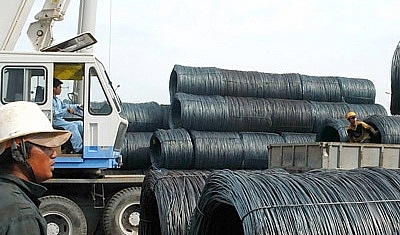Firms urged to upgrade technology to save energy
 |
| The country has striven to reduce energy consumption in energy-intensive industries such as steel production. - Photo scp.gov.vn |
A report from the Ministry of Industry and Trade at a forum on saving energy showed energy consumption in the industrial sector accounted for more than 47 per cent of the country’s total consumption. Currently, primary energy sources do not meet the economy’s energy demand. Viet Nam has to import coal for electricity generation and will import liquefied petroleum gas (LPG) from 2023.
Hoang Quoc Vuong, deputy minister of Industry and Trade, said with GDP growth of 7 per cent, the country would need 235 billion kWh electricity by 2020, 352 billion kWh by 2025 and 506 billion kWh by 2035. Although the growth rate of electricity demand in the future would be much lower than before, at about 8.5 per cent in 2021-25 and 7.5 per cent in 2026-30 (those in the previous period was more than 12 per cent year), the power demand would still very high.
Viet Nam’s electricity system has about 54,000MW including fossil and renewable energy. The country will need some 60,000MW for power demand in 2020 and 130,000MW by 2030.
“This has been a big challenge for the country’s energy sector as many power projects have seen slow progress. It is not easy to arrange capital for new investment projects on power generation and grid. Meanwhile, coal and gas for power generation have been imported," he said, adding that using energy effectively would contribute to ensuring electricity supply.
Statistics from the ministry’s Energy Efficiency and Sustainable Development Department revealed that in 2011-15, Viet Nam saved 5-8 per cent of its total energy consumption, equivalent to 11-17 million tonnes of oil.
Consumption in energy-intensive industries also declined gradually in this period, such as steel production (down 8.09 per cent), cement (6.33 per cent) and textiles (7.32 per cent).
Trinh Quoc Vu, the department’s deputy director, said according to the national programme on economical and efficient energy use for 2019-30, Viet Nam plans to reduce the energy consumption by up to 16.5 per cent in the steel sector, 10 per cent in chemical manufacturing, 11 per cent in cement production and 24.81 per cent in plastics production compared to 2015-18.
Experts said applying new technologies is an effective way to save energy in the industrial production amidst surging demand and problems in power supply.
Assoc. Prof., Dr. Tran Dinh Thien, former Director of the Viet Nam Institute of Economics, said sustainable and efficient energy use needs special attention, warning of a surge of old and energy wasting technologies in Viet Nam as many investors shift projects to the country to avoid the impact of US-China trade tension.
Other participants said apart from promoting energy saving habits, new technological solutions should be applied to improve energy efficiency.
Chairman of the Viet Nam Automation Association Nguyen Quan, also former Minister of Science and Technology, said about 30 per cent of the electricity output is currently used for lighting. If half of the amount of electricity consumed in this field is saved by using LED lights, it is equivalent to the energy generated by a 4,000MW nuclear power plant. New technologies will also help save about 10 per cent of the electricity used by the 10 million air conditioners nationwide.
Do Huu Hao, chairman of the Viet Nam Energy Conservation and Energy Efficiency Association, also highlighted the need to renovate technology and improve productivity to save energy, calling for activities to assist businesses to apply energy efficiency solutions.
What the stars mean:
★ Poor ★ ★ Promising ★★★ Good ★★★★ Very good ★★★★★ Exceptional
 Tag:
Tag:
Related Contents
Latest News
More News
- Vietnam's top 500 value-creating enterprises announced (December 27, 2025 | 08:00)
- The PAN Group shaping a better future with ESG strategy (December 26, 2025 | 09:00)
- Masan Consumer officially lists on HSX, marking the next phase of value creation (December 25, 2025 | 13:20)
- MCH to become the largest consumer stock on VN-Index (December 24, 2025 | 11:05)
- Oil and gas firms post strong 2025 results (December 22, 2025 | 17:42)
- SABECO wins multiple international beer awards (December 22, 2025 | 17:41)
- UOB sees Vietnam growth easing in fourth quarter (December 22, 2025 | 17:39)
- First members of Danang International Finance Centre revealed (December 22, 2025 | 17:39)
- Human-centred governance seen as key to AI development (December 19, 2025 | 18:19)
- Top 10 notable events of Vietnam’s industry and trade sector in 2025 (December 19, 2025 | 14:00)
























 Mobile Version
Mobile Version